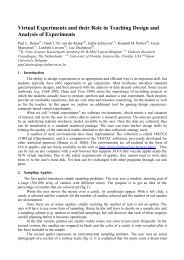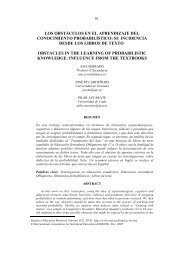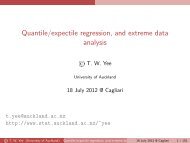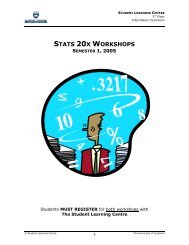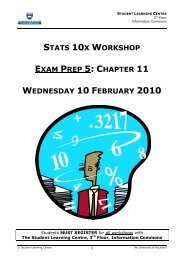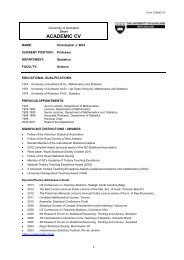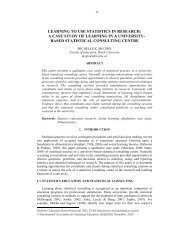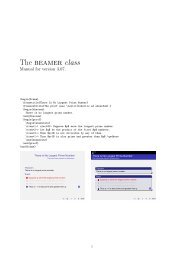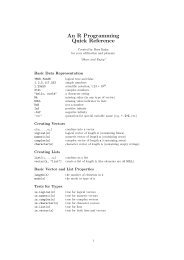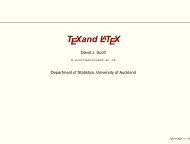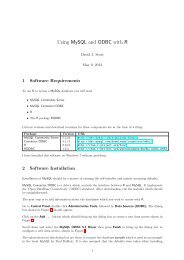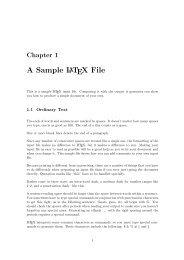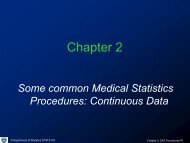modeling the growth of students' covariational reasoning during an ...
modeling the growth of students' covariational reasoning during an ...
modeling the growth of students' covariational reasoning during an ...
Create successful ePaper yourself
Turn your PDF publications into a flip-book with our unique Google optimized e-Paper software.
12<br />
educators strive to underst<strong>an</strong>d <strong>an</strong>d improve students’ ability to reason with <strong>an</strong>d<br />
underst<strong>an</strong>d covariation.<br />
Although researchers have examined peoples’ <strong>covariational</strong> <strong>reasoning</strong> on both<br />
dichotomous <strong>an</strong>d continuous variables, <strong>the</strong>re have been few studies that have examined<br />
<strong>the</strong> development <strong>of</strong> students’ <strong>reasoning</strong> about covariation in <strong>an</strong> introductory statistics<br />
course <strong>an</strong>d <strong>the</strong> optimal placement <strong>of</strong> bivariate qu<strong>an</strong>titative data <strong>an</strong>alysis. The literature<br />
reviewed has suggested that students’ <strong>reasoning</strong> about covariation could be influenced by<br />
several factors, including students’ developing <strong>reasoning</strong> about univariate distribution.<br />
Therefore, three research questions were used to frame this study:<br />
1. What is <strong>the</strong> nature, or pattern <strong>of</strong> ch<strong>an</strong>ge in students’ development in <strong>reasoning</strong><br />
about qu<strong>an</strong>titative bivariate data throughout <strong>an</strong> introductory statistics course?<br />
2. Is <strong>the</strong> sequencing <strong>of</strong> qu<strong>an</strong>titative bivariate data within a course associated with<br />
differences in <strong>the</strong> pattern <strong>of</strong> ch<strong>an</strong>ge in students’ <strong>reasoning</strong> about qu<strong>an</strong>titative<br />
bivariate data?<br />
3. Are ch<strong>an</strong>ges in students’ <strong>reasoning</strong> about <strong>the</strong> foundational concepts <strong>of</strong><br />
distribution associated with differences in <strong>the</strong> pattern <strong>of</strong> ch<strong>an</strong>ge in students’<br />
<strong>reasoning</strong> about qu<strong>an</strong>titative bivariate data?<br />
3.1. OVERVIEW OF STUDY<br />
3. METHODOLOGY<br />
This study took place <strong>during</strong> <strong>the</strong> fall semester <strong>of</strong> <strong>the</strong> 2005/2006 school year. It<br />
involved four cohorts <strong>of</strong> a one-semester (three credit hours), non-calculus based<br />
introductory statistics course taught in <strong>the</strong> College <strong>of</strong> Education at a mid-western<br />
university in <strong>the</strong> United States <strong>of</strong> America. Two different instructors taught <strong>the</strong>se four<br />
cohorts. All four cohorts met in a computer lab two times a week for <strong>an</strong> hour <strong>an</strong>d fifteen<br />
minutes each time. Each <strong>of</strong> <strong>the</strong>se cohorts had <strong>an</strong> enrollment <strong>of</strong> about 30 students.<br />
This study utilized linear mixed-effects models (LMM) to examine ch<strong>an</strong>ge in<br />
students’ development <strong>of</strong> <strong>reasoning</strong> about qu<strong>an</strong>titative bivariate data. Because <strong>the</strong><br />
<strong>modeling</strong> <strong>of</strong> ch<strong>an</strong>ge requires individuals to be measured on <strong>the</strong> same concept in temporal<br />
sequence, a repeated-measures, or longitudinal design was employed. Students enrolled<br />
in a collegiate level introductory statistics course were assessed on <strong>the</strong>ir <strong>reasoning</strong> about<br />
qu<strong>an</strong>titative bivariate data four times <strong>during</strong> a semester. Examining <strong>the</strong> ch<strong>an</strong>ge in<br />
students’ <strong>reasoning</strong> about qu<strong>an</strong>titative bivariate data over <strong>the</strong>se four time points addressed<br />
<strong>the</strong> first research question.<br />
To examine <strong>the</strong> association between course sequencing <strong>an</strong>d <strong>the</strong> patterns <strong>of</strong> ch<strong>an</strong>ge in<br />
students’ <strong>reasoning</strong> about qu<strong>an</strong>titative bivariate data, <strong>the</strong> two instructors <strong>of</strong> <strong>the</strong> course<br />
used in <strong>the</strong> study were used as blocks to r<strong>an</strong>domly assign each cohort <strong>of</strong> <strong>the</strong> course to one<br />
<strong>of</strong> two different course sequences (see Table 1). These two sequences both started with<br />
<strong>the</strong> topics <strong>of</strong> sampling <strong>an</strong>d exploratory data <strong>an</strong>alysis (EDA). Then <strong>the</strong> first sequence<br />
continued with <strong>the</strong> topic <strong>of</strong> qu<strong>an</strong>titative bivariate data followed by sampling distributions,<br />
probability, <strong>an</strong>d inference. The second sequence followed EDA with sampling<br />
distributions, probability, inference, <strong>an</strong>d ended <strong>the</strong> course with <strong>the</strong> topic <strong>of</strong> qu<strong>an</strong>titative<br />
bivariate data.



